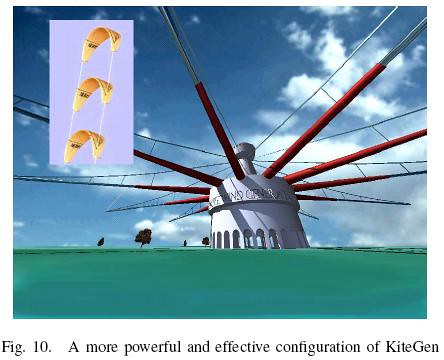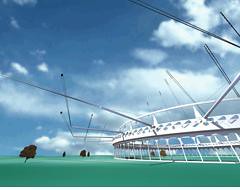20 Megawatt wind turbines are feasible, according to a new report from the EU-funded UpWind project, published at the EWEA 2011 Annual Event in Brussels.
The UpWind project explored the design limits of upscaling wind turbines to 20 Megawatt (MW) and found that they would have rotor diameters of around 200 metres, compared to some 120 metres on today’s 5 MW turbines.
108 page Upwind report from March 2011
Amongst the main innovations UpWind suggests for a 20 MW wind turbine are:
Blades
· Lowering fatigue loads on blades allows longer and lighter blades to be built. Loads can be lowered in the ways listed below:
· Fore-bending blades and using more flexible materials – this could lower fatigue loads by 10%.
· Using individual blade control – this could lower fatigue loads by 20-30%.
· Putting the blade in two sections (like an aeroplane wing), allowing each to be controlled separately – this could lower fatigue loads by 15%. It also makes it easier to transport the blade.
Adaptation
· The future smart wind turbine would be able to adapt its position and the pitch of its blade to local wind conditions.
Wind farm layout
· Lowering the power output of the first row of turbines allows for higher overall wind farm efficiency.
Control and maintenance
· Putting sensors on one wind turbine allows the fatigue loading on the other turbines to be estimated if the relationship of fatigue loading between the wind turbines is known.
· Loads can be alleviated preventatively by evaluating the upcoming gust before it arrives at the turbine. A nacelle-mounted LIDAR is sufficiently accurate for wind energy applications.

The extrapolated 20 MW design would weigh 880 tonnes on top of a tower making it impossible to store today at a standard dockside, or install offshore with the current installation vessels and cranes.
Other Proposed Superlarge Wind Systems
A new spin-out company from The University of Nottingham aims to lower wind energy costs by four times and reduce the cost of storing excess wind energy by five times.
The industry has converged on a consensus that large wind turbines should be three-bladed, horizontal-axis machines on top of a tubular tower. This is good up to 150 meters in diameter.
Prof Garvey turbine is dramatically different: a horizontal-axis machine with eight blades — four long and four short. A floating framework replaces the tower, and it converts wind power internally within the blades. Think of a bicycle wheel rotating slowly, and a loose bead on each spoke. The beads represent pistons traveling back and forth inside tubes in the blades, compressing air as they do so.
The baby of the family is a 200 meter-diameter machine producing 18MW in a decent wind and costing less than 40% of the 40 million pounds you’d spend on a corresponding set of direct-generating machines. Her big sisters might easily reach 400 meter in diameter and could be 50% more cost-effective.
Energy-storage capability comes as an added bonus. I am suggesting “energy bags” held down on the ocean floor with ballast weights about 600 meters below the surface. Ireland has such deep water in the Atlantic suitably close to shore.

Proposed carousel of airfoils for a 100 megawatt class kitegen generator

Newer imagining of a large scale kitegen generator. A generator ring is pulled and the support structure stays in place
Superconductors could reduce the size and weight of the generator for wind power and reduce the difficulties in making larger wind power systems There is a research project on 10 megawatt wind turbines using superconductors.
If you liked this article, please give it a quick review on ycombinator or StumbleUpon. Thanks

Brian Wang is a Futurist Thought Leader and a popular Science blogger with 1 million readers per month. His blog Nextbigfuture.com is ranked #1 Science News Blog. It covers many disruptive technology and trends including Space, Robotics, Artificial Intelligence, Medicine, Anti-aging Biotechnology, and Nanotechnology.
Known for identifying cutting edge technologies, he is currently a Co-Founder of a startup and fundraiser for high potential early-stage companies. He is the Head of Research for Allocations for deep technology investments and an Angel Investor at Space Angels.
A frequent speaker at corporations, he has been a TEDx speaker, a Singularity University speaker and guest at numerous interviews for radio and podcasts. He is open to public speaking and advising engagements.



